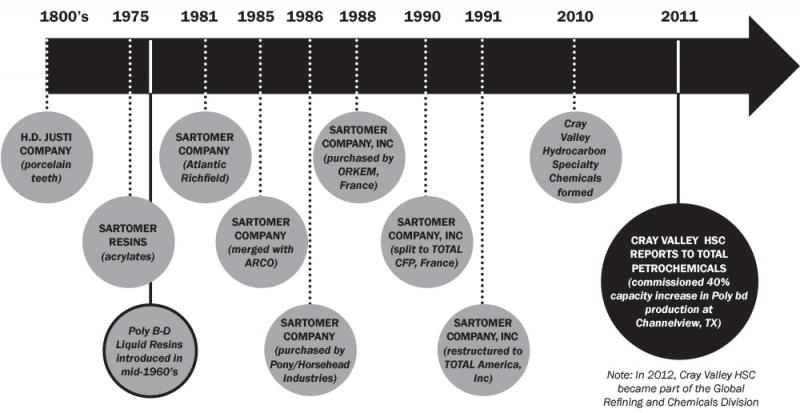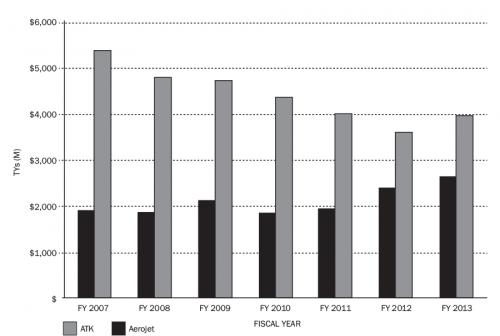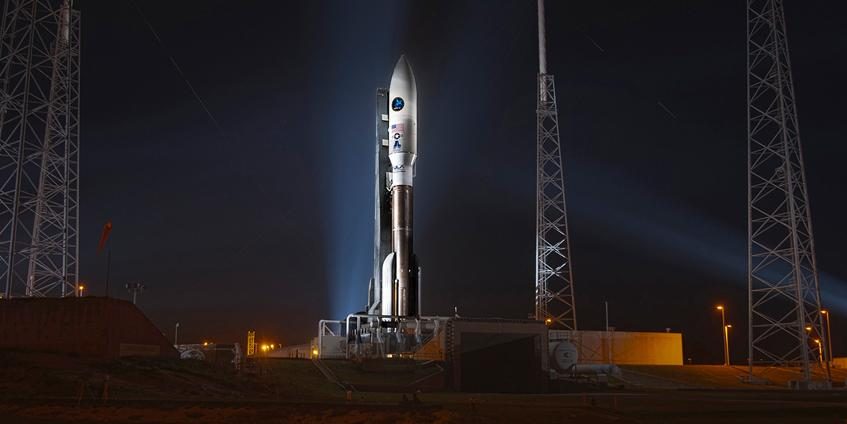BEGINNINGS OF HTPB IN THE DEPARTMENT OF DEFENSE (DoD)
For nearly 60 years, and at least two generations of scientists and engineers, hydroxyl-terminated polybutadiene (HTPB) has enjoyed a prominent place in the Defense business. Chemically similar to polybutadiene acrylonitrile (PBAN) and carboxyl- terminated polybutadiene (CTPB) [1], HTPB was recognized by rocket scientists as far back as the early 1960s as offering new opportunities to improved performance and enhanced mechanical properties [2]. First introduced by ARCO Chemical Company (Sinclair Petrochemicals, Inc.), HTPB also gained favor as the “Poly B-D Liquid Resin” of choice for many commercial applications, such caulks, foams, sealants, and adhesives [3]. These applications still exist today in the form of curable polyurethane (PU) systems of HTPB, along with its extensive use as a binder in rocket motor propellants and liners.
At the start, PUs based on HTPB and isocyanates showed many desirable features not attainable with other systems, such as excellent hydrolytic stability, compatibility with oil-type plasticizers (coined as “oil extendibility”), improved adhesion to substrates, and improved low-temperature properties, with embrittlement at or below -80 °C. The latter feature allowed scientists to extend the operational temperature range of rocket motors using HTPB binders, especially those destined for air-to- air tactical use.
The HTPB polymer has been the subject of extensive characterization across the world in terms of chemical structure, microstructure, and reactivity, as well as aging characteristics of PU networks [4, 5]. Devices as small as miniature model rockets and large-scale motors up to 93 inches in diameter (Castor 120®) are in use today because of the desirable properties, manufacturability, and versatility of HTPB propellants (when combined with an ammonium perchlorate [AP] oxidizer) [6].
The largest HTPB composite propellant motor ever produced was the Titan IV Solid Rocket Motor Upgrade (SRMU) strap-on booster, which was 10.5 ft in diameter by 112 ft in length and weighed more than 770,000 lbs [7]. It was built by ATK between 1992 and 2001 for flights of the Air Force’s Titan IVB launch vehicle through 2005, when it was retired. Aerojet also manufactured the 5 foot diameter by 56 foot long AJ-60A strap-on HTPB solid rocket booster for the Atlas V launch vehicle from 1999 to 2003. Orbital ATK’s new GEM-63 booster is destined to replace the AJ-60A motor for future Atlas V launches, while an extended-length GEM-63XL is planned for use on the Vulcan launch vehicle [8]. Both strategic and tactical rocket motor propellants have been highly successful using HTPB for many years [9].
THE STORY CONTINUES
The current producer and qualified supplier of Poly bd® resins is Cray Valley Hydrocarbon Specialty Chemicals, which is now owned by the French company TOTAL (see history in Figure 1) [10]. Cray Valley manufactures military grade HTPB at the original location in Channelview, Texas that was first established by Sinclair/ARCO in the 1960s. Cray Valley currently produces two forms of resins, R-45M and R-45HTLO [11], both of which are the only qualified materials in use by the DoD for a wide variety of rocket motor and warhead applications (see Table 1).

Figure 1: Cray Valley HSC Timeline.
| Characteristic | R-45M | R-45HTLO |
| Primary uses | Rocket motor propellant and liner binder | Commercial use (adhesives, sealants, etc.); warhead explosive binder |
| Hydroxyl value (meq/g)a | 0.7–0.80 | 0.7–0.85 |
| Approximate equivalent weight (g/mole) | 1,333 | 1,250 |
| Approximate functionality | 2.2–2.4 | 2.4–2.6 |
| a Specification MIL-H-85497 | ||
Due to the high demand for commercial HTPB (primarily R-45HTLO), Cray Valley has recently expanded and upgraded the Channelview, TX, facility. This move will help make the R-45M product more readily available to the Defense industry. At the time of this writing, rocket motor suppliers are in the process of requalifying Cray Valley R-45M with material made from the upgraded facility, and preliminary indications are positive, especially since there have been concerns over reproducibility over the past several years [12, 13].
CONCERNS AND CHALLENGES
With the shrinking demands from the DoD, the viability of maintaining an adequate industrial base of critical materials has been a major and growing concern for the Defense industry [14]. Qualifying second sources, and thus helping to eliminate the risky single-source condition found with many critical Defense-related materials, is a top concern for the Office of the Secretary of Defense (OSD) as it strives to maintain and advance the U.S. ability to remain responsive in times of crises [15]. Recently, MACH I Incorporated has come forward to serve as a second source of HTPB, with its official product name HTPB-45M® [16]. This material is being manufactured by an Emerald CVC Specialty Chemicals Company plant located in Cuyahoga Falls, OH, and it easily meets current specification requirements. Supplying the Defense industry for more than 30 years with specialty chemicals, and working under Small Business Innovation Research (SBIR) and OSD contracts, the MACH I product is showing promise for this critical Defense material.
Additionally, the down-turn in the solid rocket motor (SRM) business outlook over the past several years has reduced future prospects considerably for propellant materials such as HTPB. As mandated by Public Law 110-181 (dated 28 January 2008), Mr. Robert Reed from the Office of the Under Secretary of Defense (OUSD) compiled a presentation entitled “Solid Rocket Motor (SRM) Congressional Interest” in 2009. This presentation was a synopsis of a report to Congress on SRM industrial capabilities in the United States [17]. The report contained industrial base information on space launch, strategic, missile defense, and tactical SRM business segments, including the down-turn in propellant and material needs that resulted from the completion of the U.S. Space Shuttle program, as well as subsequent reductions in SRM booster requirements.
Mr. Reed outlined, through the data extracted and compiled in Table 2, how the ongoing SRM businesses compared to one shuttle reusable solid rocket motor (RSRM). For example, to compensate for the loss of one shuttle RSRM, the Guided Multiple- Launch Rocket System (GMLRS) tactical business needed to increase by 5,121 units, an approximate 50% increase above quantity projections through 2012 [18, 19]. Because Presidential DoD budgets and projections for the past several years have been flat or declining, increased demand for materials such as HTPB is unlikely and may force large suppliers to comtemplate leaving the Defense business entirely.
Based on Mr. Reed’s projections for SRMs through 2013, the anticipated quantities for HTPB amounted to less than 170,000lbs annually for both major U.S. propulsion contractors, Orbital ATK and Aerojet Rocketdyne (see also Moore 1997 for past usage[20]). Figure 2 shows the missile procurement of these two contractors from 2007 through 2013.
| Missile Program | Pounds of Propellant | Equivalent No. of SRMS to Equal One Space Shuttle RSRM |
| Space Shuttle RSRM | 1,106,059 | 1 |
| Trident II D-5 | 110,200 | 10 |
| Minuteman III (MM III) | 66,642 | 17 |
| Ground Missile Defense (GMD) | 43,469 | 25 |
| Kinetic Energy Interceptor (KEI) | 20,026 | 55 |
| Patriot Advanced Capability-3 (PAC-3) | 350 | 3,160 |
| Guided Multiple Launch Rocket System (GMLRS) | 216 | 5,121 |
| Advanced Medium-Range Air-to-Air Missile (AMRAAM) | 133 | 9,788 |
| Hellfire | 20 | 55,303 |
| Javelin | 3 | 368,686 |
| NASA man-launched space systems a key player in large SRM sector and propellant subtier base. | ||

Figure 2: DoD Missile Procurement by Prime Contractor.
However, the HTPB polymer continues to find use around the world and in advanced rocket motors, such as those shown in the Table 3 [21]. SRM satellite launch vehicles from Japan and India, as well as hybrid rockets for Space Ships One and Two in the United States, are some of the applications. Combined with a peroxide oxidizer, the unique Dreamchaser spaceplane uses an HTPB hybrid rocket motor. One of the more exotic uses is in a hybrid rocket developed by NAMMO of Norway for a land speeder that originated in the United Kingdom [22]. The UK Ministry of Science Department of Innovation, Universities, and Skills is attempting to break the land-speed record with a vehicle known as Bloodhound SSC. The vehicle is being designed to reach a speed of 1,000 mph. This unique work is part of an education project designed to promote science, technology, engineering, and mathematics (STEM) to young students and requires the use of many talents in design, analysis, engineering, and testing across several institutions.
| System | Subsystem | Rocket Type | Country of Origin | Reference |
| Satellite Launch Vehicle | Ariane V | Strap-on SRM | France (EADS/LV) | ESA |
| Satellite Launch Vehicle | M-5 Rocket (aka M-v, Mu-5) | SRM | Japan (ISAS) | Wikipedia(M-V) (see also: Wikipedia (JAXA) |
| Satellite Launch Vehicle |
Polar Satellite Launch Vehicle (PSLV) | SRM | India (ISRO) | Wikipedia (Polar Satellite Launch Vehicle) |
| Space Ship One and Space Ship Two | Hybrid Rocket With Nitrous Oxide | Hybrid Motor | United States (SpaceDev) |
Wikipedia (Hybrid Rocket) (see also: Wikipedia (SpaceDev)) |
| Dreamchaser Spaceplane | Hybrid Rocket With Peroxide | Hybrid Motor | United States (SpaceDev) |
Wikipedia (Dream Chaser) (see: also: Wikipedia (Sierra Nevada Corporation)) |
| Bloodhound SSC Land Speeder | Hybrid Rocket With Peroxide | Hybrid Motor | United Kingdom | Wikipedia (Bloodhound_SSC) |
LOOKING AHEAD
So what does the future hold for HTPB in the defense business? Although quantity demands may have diminished, the need for this highly effective polymer will not. HTPB has proven time and again to be the polymer of choice for systems in high-rate production, advanced development, and new research, especially in the area of AP-based rocket motor propellants and high- performance warheads. The future may show a need for specialized HTPB having performance not yet attainable, such as formulations with improved safety from thermal insult, higher toughness and strain capability, and expanded capability under extreme high and low temperature operation. The next 60 years may see dramatic shifts in Defense technologies, but highly successful materials such as HTPB are sure to remain important and useful for military applications.
References:
- Moore, Thomas L. “Polybutadienes Dominate for 40 Years.” Chemical Propulsion Information Agency Bulletin, vol. 24, no. 2, March 1988.
- Hunley, J. D. “The History of Solid-Propellant Rocketry: What We Do and Do Not Know.” AIAA 99-2925, Invited Paper at the 35th AIAA, ASME, SAE, ASEE Joint Propulsion Conference and Exhibit, Los Angeles, CA, 20–24 June, 1999.
- “Poly-BD Liquid Resins.” Sinclair Product Data Bulletin Number 505, June 1967.
- Mahanta, Abhay K., and Devendra D. Pathak. “HTPB-Polyurethane: A Versatile Fuel Binder for Composite Solid Propellant.” Polyurethane, edited by Dr. Fahmina Zafar, InTech, 2012.
- Strange, Karen L. (Ed.). “R-45M Characterization–1985 JPM Specialist Session.” San Diego, CA, 10 April 1985.
- Aerocon Systems. “Estes Rocket Motors.” http://aeroconsystems.com, accessed 2016.
- SpaceDaily. “ATK Gives Titan 4 a Solid Kick.” http://www.spacedaily.com/news/booster-00b.html, accessed 2016.
- Wikipedia. “Graphite-Epoxy Motor.” https://en.wikipedia.org/wiki/Graphite-Epoxy_Motor, accessed 2016.
- Purdue University. “Solid Rocket Motors.” Purdue AAE Propulsion, https://engineering.purdue.edu/~propulsi/propulsion/rockets/solids.html, accessed 2016.
- Cray Valley. “Poly bd®.” http://www.crayvalley.com/products/poly-bd-liquid-polybutadiene, accessed 2016.
- Cray Valley. “Poly bd® R-45HTLO and Poly bd® R-45M.” Technical Datasheets, July 2010.
- Brady, Michael, and Robert Wardle. Personal communication with author. Orbital ATK, May 2015.
- Clark, Kerry. “Chemical, Physical and Aging Properties of HTPB R-45m Polymer.” JANNAF HTPB Variability Workshop, CPIAC Abstract Number 2009-0105CM, 8 December 2009.
- Erwin, Sandra I. “Pentagon Running Out of U.S. Suppliers of Energetic Materials.” http://www.nationaldefensemagazine.org/blog/Lists/Posts/Post.aspx?ID=1095, accessed 2016.
- Olson, David. “Critical Energetic Material Initiative.” National Defense Industrial Association IM/EM Technology
Symposium, Las Vegas, NV, 16 May 2012. - MACH I Incorporated. “HTPB-45M®.” Technical Information Sheet, to be published.
- Reed, Robert. “Solid Rocket Motor (SRM) Congressional Interest.” December 2009.
- Pincoski, LTC Mark. “Precision Guided Missiles and Rockets Program Review.” Presented at Precision Strike Annual
Programs Review, 27 April 2007. - George C. Marshall and Claremont Institutes. “Guided MLRS,” 2016.
- Moore, Thomas. “Assessment of HTPB and PBAN Propellant Usage in the United States.” Publication Number AIAA-1997- 3137, American Institute of Aeronautics and Astronautics, 1997.
- Wikipedia. “Hydroxyl-Terminated Polybutadiene.” https://en.wikipedia.org/wiki/Hydroxyl-terminated_polybutadiene, accessed 2016.
- Wikipedia. “Bloodhound SSC.” https://en.wikipedia.org/wiki/Bloodhound_SSC, accessed 2016.


